Cornflower meadows create a vibrant habitat filled with blue blossoms that attract bees and butterflies, enhancing biodiversity in cottage gardens. Their natural, carefree growth adds a charming, rustic appeal while providing essential nectar sources for pollinators. Cultivating a cornflower meadow supports sustainable gardening practices and promotes a thriving ecosystem.
Introduction to Cornflower Meadows in Cottage Gardens
Cornflower meadows introduce vibrant blue blossoms that enhance the natural charm of cottage gardens, creating a visually striking and ecologically rich habitat. These meadows support pollinators like bees and butterflies, promoting biodiversity while requiring minimal maintenance. Incorporating cornflower meadows in cottage gardens blends floral beauty with sustainable gardening practices, making them ideal for both aesthetic appeal and environmental benefits.
Benefits of Incorporating Cornflowers in Cottage Garden Design
Incorporating cornflowers in a cottage garden design enhances biodiversity by attracting essential pollinators such as bees and butterflies, which improves overall plant health and productivity. Their vibrant blue blooms provide striking visual contrast against traditional cottage garden plants, enriching aesthetic appeal and seasonal interest. Cornflowers also require minimal maintenance and adapt well to various soil types, making them an ideal choice for sustainable, low-effort garden management.
Choosing the Right Cornflower Varieties for Meadows
Selecting the right cornflower varieties for a cottage garden meadow enhances biodiversity and visual appeal. Opt for native species like Centaurea cyanus, known for its vibrant blue flowers and adaptability to local soil conditions. Incorporate a mix of cultivars with varying bloom times and colors to ensure continuous floral display and support pollinators throughout the growing season.
Site Selection and Soil Preparation for Cornflower Meadows
Cornflower meadows thrive best in well-drained, moderately fertile soils with a neutral to slightly alkaline pH, making sandy loam or loamy soils ideal for site selection. Preparing the soil involves thorough clearing of existing vegetation, light tilling to a depth of 10-15 cm, and incorporating organic matter such as compost to enhance nutrient content and soil structure. Ensuring a sunny location with minimal shading promotes vigorous growth and prolific flowering of cornflower (Centaurea cyanus) in cottage garden meadows.
Step-by-Step Cornflower Meadow Planting Guide
Prepare the soil by loosening it and removing weeds to create an ideal planting environment for a Cornflower meadow. Scatter Cornflower seeds evenly across the prepared soil, then lightly rake to ensure good seed-to-soil contact without burying the seeds too deeply. Water the area gently but consistently, maintaining moisture for germination while avoiding waterlogging to encourage healthy growth and vibrant blooms.
Companion Plants for Cornflowers in Cottage Gardens
Cornflowers thrive alongside companion plants such as poppies, chamomile, and nigella in cottage gardens, enhancing both visual appeal and biodiversity. These companions attract pollinators like bees and butterflies, promoting healthy growth and vibrant blooms. Integrating cornflowers with aromatic herbs like lavender and thyme also helps deter pests naturally while contributing to a harmonious garden ecosystem.
Seasonal Care and Maintenance Tips for Cornflower Meadows
Cornflower meadows require regular watering during dry spells to promote healthy growth and vibrant blooms throughout the season. Deadheading spent flowers encourages continuous flowering and prevents self-seeding that can lead to overcrowding. In late autumn, cutting the meadow back to about 5-10 cm helps prepare the plants for winter dormancy and supports vigorous regrowth in spring.
Pest and Disease Management in Cornflower Meadows
Effective pest and disease management in cornflower meadows involves regular monitoring for common issues like aphids, powdery mildew, and fungal leaf spots. Employing natural predators such as ladybugs and using organic fungicides helps maintain plant health without harmful chemicals. Maintaining proper spacing and ensuring good air circulation reduce the risk of disease outbreaks in dense cornflower plantings.
Enhancing Biodiversity with Cornflowers in Cottage Gardens
Cornflower meadows in cottage gardens significantly boost biodiversity by attracting pollinators such as bees, butterflies, and hoverflies. These vibrant blue flowers provide essential nectar and pollen resources, supporting local ecosystems and promoting sustainable garden health. Cultivating cornflowers alongside native plants ensures a diverse habitat that encourages natural pest control and enhances soil fertility.
Harvesting and Preserving Cornflowers for Home Use
Harvest cornflowers when their petals are fully open and vibrant, usually in mid to late summer, to ensure maximum color and fragrance. Gently cut the stems early in the morning after dew has dried, then dry the flowers by hanging them upside down in a dark, well-ventilated area to preserve their shape and hue. Store dried cornflowers in airtight containers away from direct sunlight to maintain their decor and culinary qualities for home use.
Cornflower meadow Infographic

 gardenot.com
gardenot.com